A Report on Employee Motivation and the Impact of Workplace Factors
VerifiedAdded on 2023/06/12
|8
|1886
|427
Report
AI Summary
This report explores the factors that motivate employees in the workplace, including both extrinsic and intrinsic motivation, and applies Maslow's hierarchy of needs to understand these drives. It identifies promotion, salary, and work environment as key motivators. Furthermore, the report discusses positive factors such as company culture, rewards and recognition, and professional development opportunities, as well as negative factors like job stress, workplace conflicts, and poor management. Strategies to cope with negative factors include providing growth opportunities, fostering trust and respect, and enhancing employee engagement. The analysis concludes that employee motivation is crucial for job satisfaction and improved performance, recommending that organizations prioritize creating a positive work environment to enhance employee experiences and overall success. Desklib provides access to this and other student-contributed assignments.
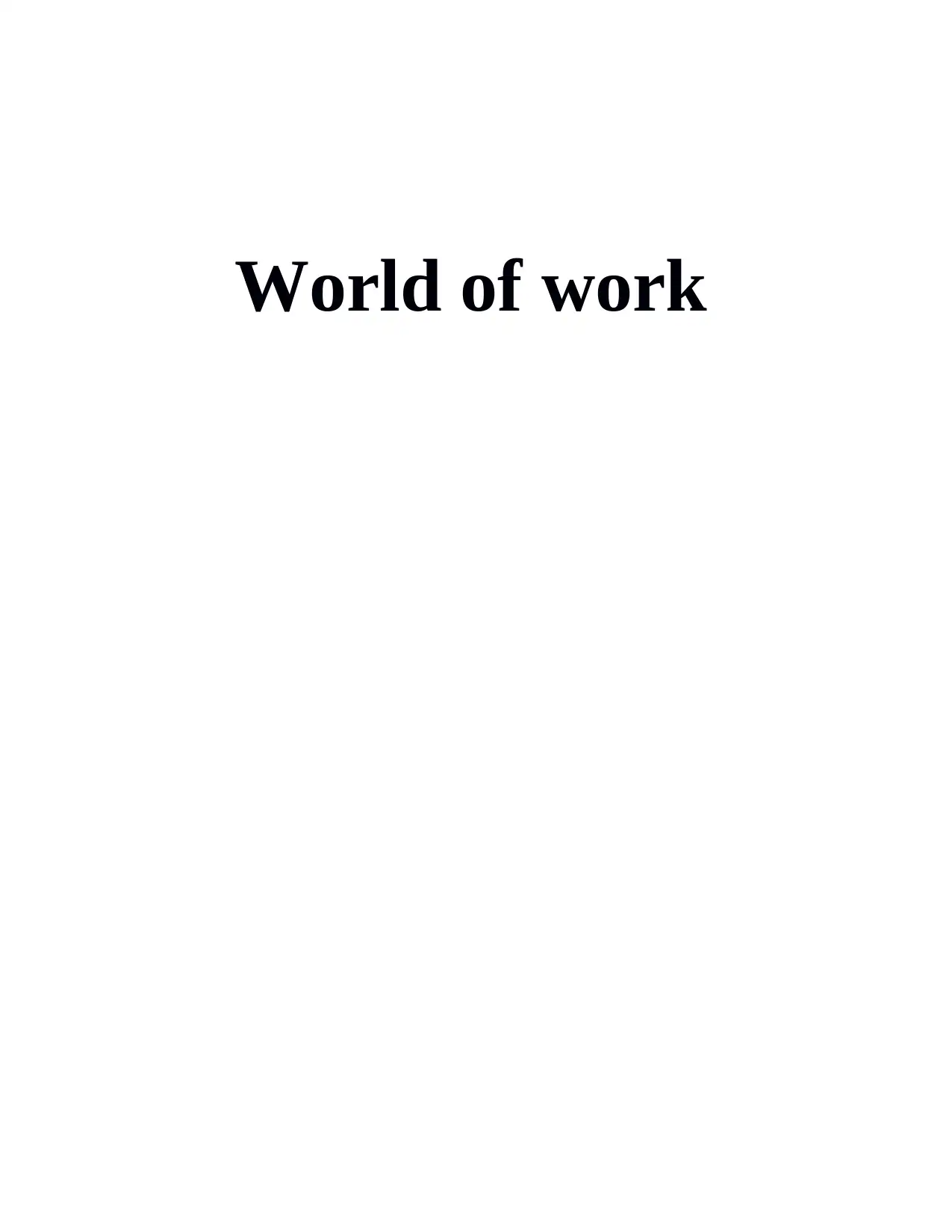
World of work
Paraphrase This Document
Need a fresh take? Get an instant paraphrase of this document with our AI Paraphraser
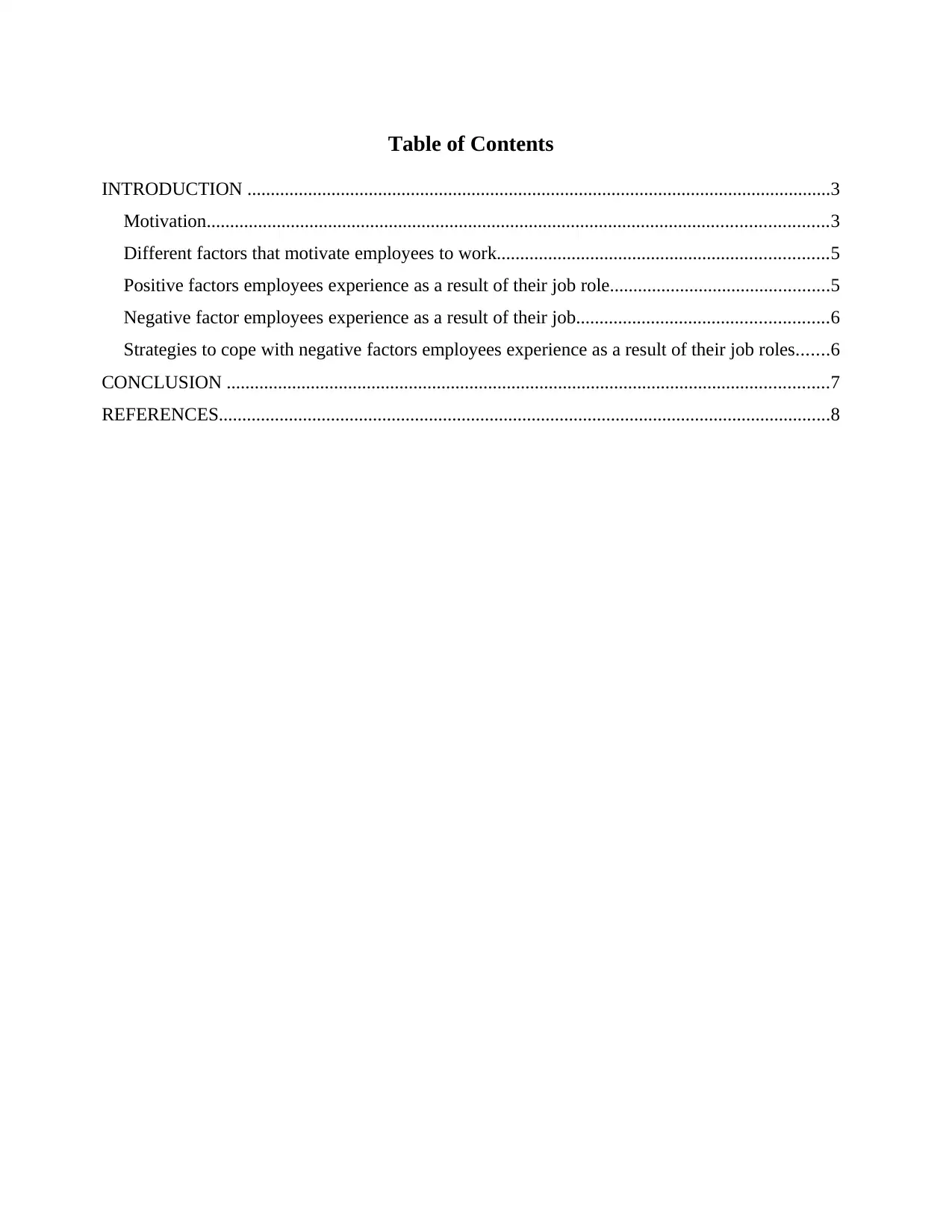
Table of Contents
INTRODUCTION .............................................................................................................................3
Motivation.....................................................................................................................................3
Different factors that motivate employees to work.......................................................................5
Positive factors employees experience as a result of their job role...............................................5
Negative factor employees experience as a result of their job......................................................6
Strategies to cope with negative factors employees experience as a result of their job roles.......6
CONCLUSION .................................................................................................................................7
REFERENCES...................................................................................................................................8
INTRODUCTION .............................................................................................................................3
Motivation.....................................................................................................................................3
Different factors that motivate employees to work.......................................................................5
Positive factors employees experience as a result of their job role...............................................5
Negative factor employees experience as a result of their job......................................................6
Strategies to cope with negative factors employees experience as a result of their job roles.......6
CONCLUSION .................................................................................................................................7
REFERENCES...................................................................................................................................8
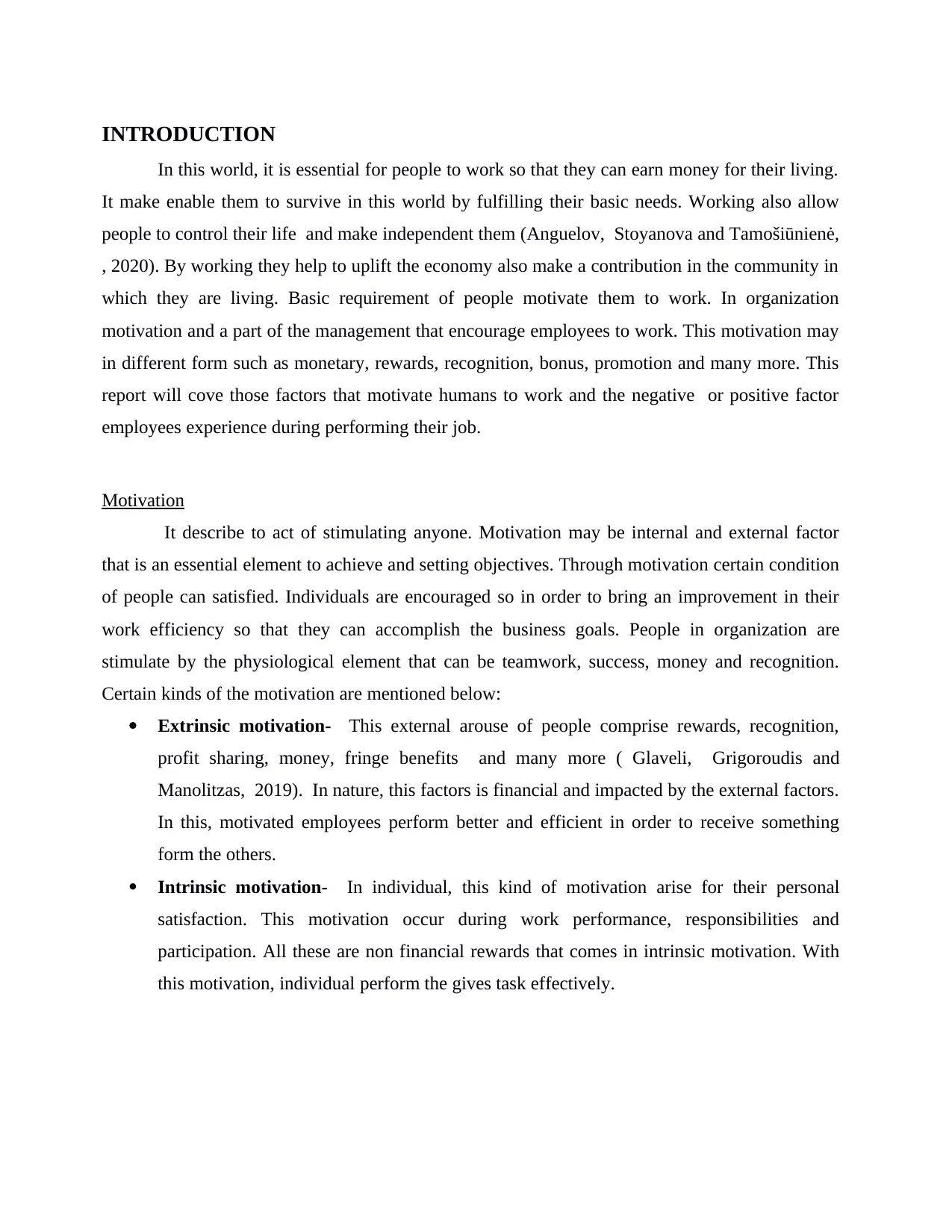
INTRODUCTION
In this world, it is essential for people to work so that they can earn money for their living.
It make enable them to survive in this world by fulfilling their basic needs. Working also allow
people to control their life and make independent them (Anguelov, Stoyanova and Tamošiūnienė,
, 2020). By working they help to uplift the economy also make a contribution in the community in
which they are living. Basic requirement of people motivate them to work. In organization
motivation and a part of the management that encourage employees to work. This motivation may
in different form such as monetary, rewards, recognition, bonus, promotion and many more. This
report will cove those factors that motivate humans to work and the negative or positive factor
employees experience during performing their job.
Motivation
It describe to act of stimulating anyone. Motivation may be internal and external factor
that is an essential element to achieve and setting objectives. Through motivation certain condition
of people can satisfied. Individuals are encouraged so in order to bring an improvement in their
work efficiency so that they can accomplish the business goals. People in organization are
stimulate by the physiological element that can be teamwork, success, money and recognition.
Certain kinds of the motivation are mentioned below:
Extrinsic motivation- This external arouse of people comprise rewards, recognition,
profit sharing, money, fringe benefits and many more ( Glaveli, Grigoroudis and
Manolitzas, 2019). In nature, this factors is financial and impacted by the external factors.
In this, motivated employees perform better and efficient in order to receive something
form the others.
Intrinsic motivation- In individual, this kind of motivation arise for their personal
satisfaction. This motivation occur during work performance, responsibilities and
participation. All these are non financial rewards that comes in intrinsic motivation. With
this motivation, individual perform the gives task effectively.
In this world, it is essential for people to work so that they can earn money for their living.
It make enable them to survive in this world by fulfilling their basic needs. Working also allow
people to control their life and make independent them (Anguelov, Stoyanova and Tamošiūnienė,
, 2020). By working they help to uplift the economy also make a contribution in the community in
which they are living. Basic requirement of people motivate them to work. In organization
motivation and a part of the management that encourage employees to work. This motivation may
in different form such as monetary, rewards, recognition, bonus, promotion and many more. This
report will cove those factors that motivate humans to work and the negative or positive factor
employees experience during performing their job.
Motivation
It describe to act of stimulating anyone. Motivation may be internal and external factor
that is an essential element to achieve and setting objectives. Through motivation certain condition
of people can satisfied. Individuals are encouraged so in order to bring an improvement in their
work efficiency so that they can accomplish the business goals. People in organization are
stimulate by the physiological element that can be teamwork, success, money and recognition.
Certain kinds of the motivation are mentioned below:
Extrinsic motivation- This external arouse of people comprise rewards, recognition,
profit sharing, money, fringe benefits and many more ( Glaveli, Grigoroudis and
Manolitzas, 2019). In nature, this factors is financial and impacted by the external factors.
In this, motivated employees perform better and efficient in order to receive something
form the others.
Intrinsic motivation- In individual, this kind of motivation arise for their personal
satisfaction. This motivation occur during work performance, responsibilities and
participation. All these are non financial rewards that comes in intrinsic motivation. With
this motivation, individual perform the gives task effectively.
⊘ This is a preview!⊘
Do you want full access?
Subscribe today to unlock all pages.

Trusted by 1+ million students worldwide
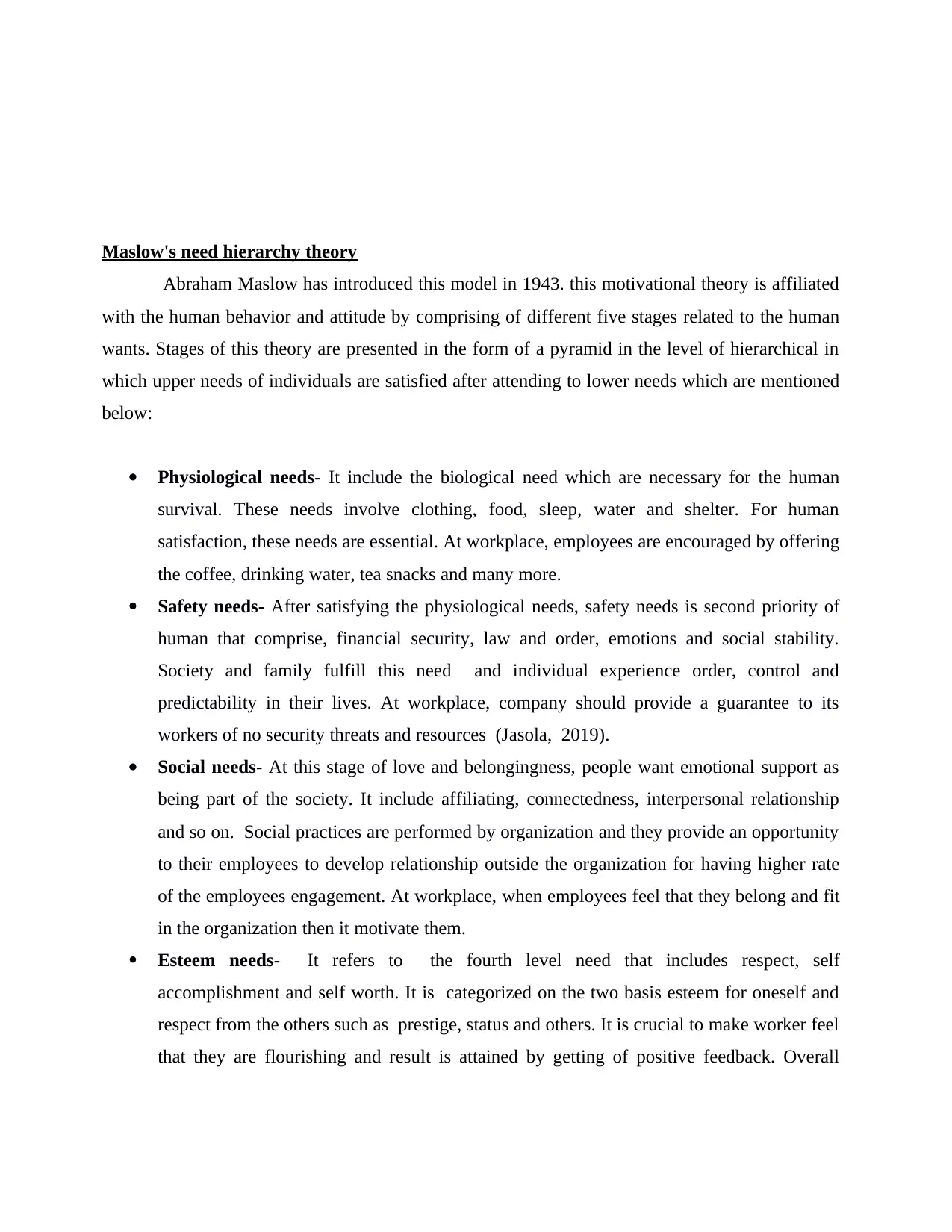
Maslow's need hierarchy theory
Abraham Maslow has introduced this model in 1943. this motivational theory is affiliated
with the human behavior and attitude by comprising of different five stages related to the human
wants. Stages of this theory are presented in the form of a pyramid in the level of hierarchical in
which upper needs of individuals are satisfied after attending to lower needs which are mentioned
below:
Physiological needs- It include the biological need which are necessary for the human
survival. These needs involve clothing, food, sleep, water and shelter. For human
satisfaction, these needs are essential. At workplace, employees are encouraged by offering
the coffee, drinking water, tea snacks and many more.
Safety needs- After satisfying the physiological needs, safety needs is second priority of
human that comprise, financial security, law and order, emotions and social stability.
Society and family fulfill this need and individual experience order, control and
predictability in their lives. At workplace, company should provide a guarantee to its
workers of no security threats and resources (Jasola, 2019).
Social needs- At this stage of love and belongingness, people want emotional support as
being part of the society. It include affiliating, connectedness, interpersonal relationship
and so on. Social practices are performed by organization and they provide an opportunity
to their employees to develop relationship outside the organization for having higher rate
of the employees engagement. At workplace, when employees feel that they belong and fit
in the organization then it motivate them.
Esteem needs- It refers to the fourth level need that includes respect, self
accomplishment and self worth. It is categorized on the two basis esteem for oneself and
respect from the others such as prestige, status and others. It is crucial to make worker feel
that they are flourishing and result is attained by getting of positive feedback. Overall
Abraham Maslow has introduced this model in 1943. this motivational theory is affiliated
with the human behavior and attitude by comprising of different five stages related to the human
wants. Stages of this theory are presented in the form of a pyramid in the level of hierarchical in
which upper needs of individuals are satisfied after attending to lower needs which are mentioned
below:
Physiological needs- It include the biological need which are necessary for the human
survival. These needs involve clothing, food, sleep, water and shelter. For human
satisfaction, these needs are essential. At workplace, employees are encouraged by offering
the coffee, drinking water, tea snacks and many more.
Safety needs- After satisfying the physiological needs, safety needs is second priority of
human that comprise, financial security, law and order, emotions and social stability.
Society and family fulfill this need and individual experience order, control and
predictability in their lives. At workplace, company should provide a guarantee to its
workers of no security threats and resources (Jasola, 2019).
Social needs- At this stage of love and belongingness, people want emotional support as
being part of the society. It include affiliating, connectedness, interpersonal relationship
and so on. Social practices are performed by organization and they provide an opportunity
to their employees to develop relationship outside the organization for having higher rate
of the employees engagement. At workplace, when employees feel that they belong and fit
in the organization then it motivate them.
Esteem needs- It refers to the fourth level need that includes respect, self
accomplishment and self worth. It is categorized on the two basis esteem for oneself and
respect from the others such as prestige, status and others. It is crucial to make worker feel
that they are flourishing and result is attained by getting of positive feedback. Overall
Paraphrase This Document
Need a fresh take? Get an instant paraphrase of this document with our AI Paraphraser
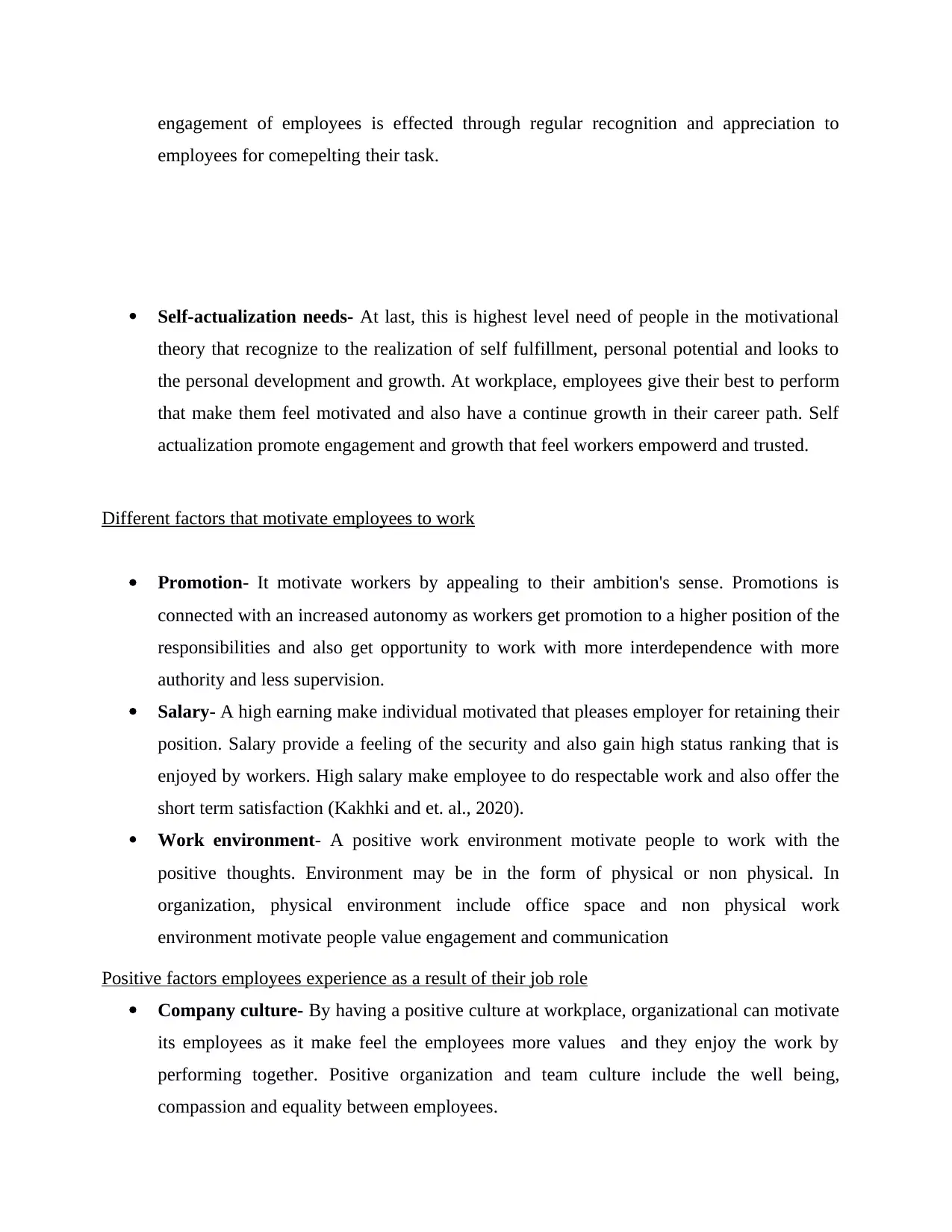
engagement of employees is effected through regular recognition and appreciation to
employees for comepelting their task.
Self-actualization needs- At last, this is highest level need of people in the motivational
theory that recognize to the realization of self fulfillment, personal potential and looks to
the personal development and growth. At workplace, employees give their best to perform
that make them feel motivated and also have a continue growth in their career path. Self
actualization promote engagement and growth that feel workers empowerd and trusted.
Different factors that motivate employees to work
Promotion- It motivate workers by appealing to their ambition's sense. Promotions is
connected with an increased autonomy as workers get promotion to a higher position of the
responsibilities and also get opportunity to work with more interdependence with more
authority and less supervision.
Salary- A high earning make individual motivated that pleases employer for retaining their
position. Salary provide a feeling of the security and also gain high status ranking that is
enjoyed by workers. High salary make employee to do respectable work and also offer the
short term satisfaction (Kakhki and et. al., 2020).
Work environment- A positive work environment motivate people to work with the
positive thoughts. Environment may be in the form of physical or non physical. In
organization, physical environment include office space and non physical work
environment motivate people value engagement and communication
Positive factors employees experience as a result of their job role
Company culture- By having a positive culture at workplace, organizational can motivate
its employees as it make feel the employees more values and they enjoy the work by
performing together. Positive organization and team culture include the well being,
compassion and equality between employees.
employees for comepelting their task.
Self-actualization needs- At last, this is highest level need of people in the motivational
theory that recognize to the realization of self fulfillment, personal potential and looks to
the personal development and growth. At workplace, employees give their best to perform
that make them feel motivated and also have a continue growth in their career path. Self
actualization promote engagement and growth that feel workers empowerd and trusted.
Different factors that motivate employees to work
Promotion- It motivate workers by appealing to their ambition's sense. Promotions is
connected with an increased autonomy as workers get promotion to a higher position of the
responsibilities and also get opportunity to work with more interdependence with more
authority and less supervision.
Salary- A high earning make individual motivated that pleases employer for retaining their
position. Salary provide a feeling of the security and also gain high status ranking that is
enjoyed by workers. High salary make employee to do respectable work and also offer the
short term satisfaction (Kakhki and et. al., 2020).
Work environment- A positive work environment motivate people to work with the
positive thoughts. Environment may be in the form of physical or non physical. In
organization, physical environment include office space and non physical work
environment motivate people value engagement and communication
Positive factors employees experience as a result of their job role
Company culture- By having a positive culture at workplace, organizational can motivate
its employees as it make feel the employees more values and they enjoy the work by
performing together. Positive organization and team culture include the well being,
compassion and equality between employees.
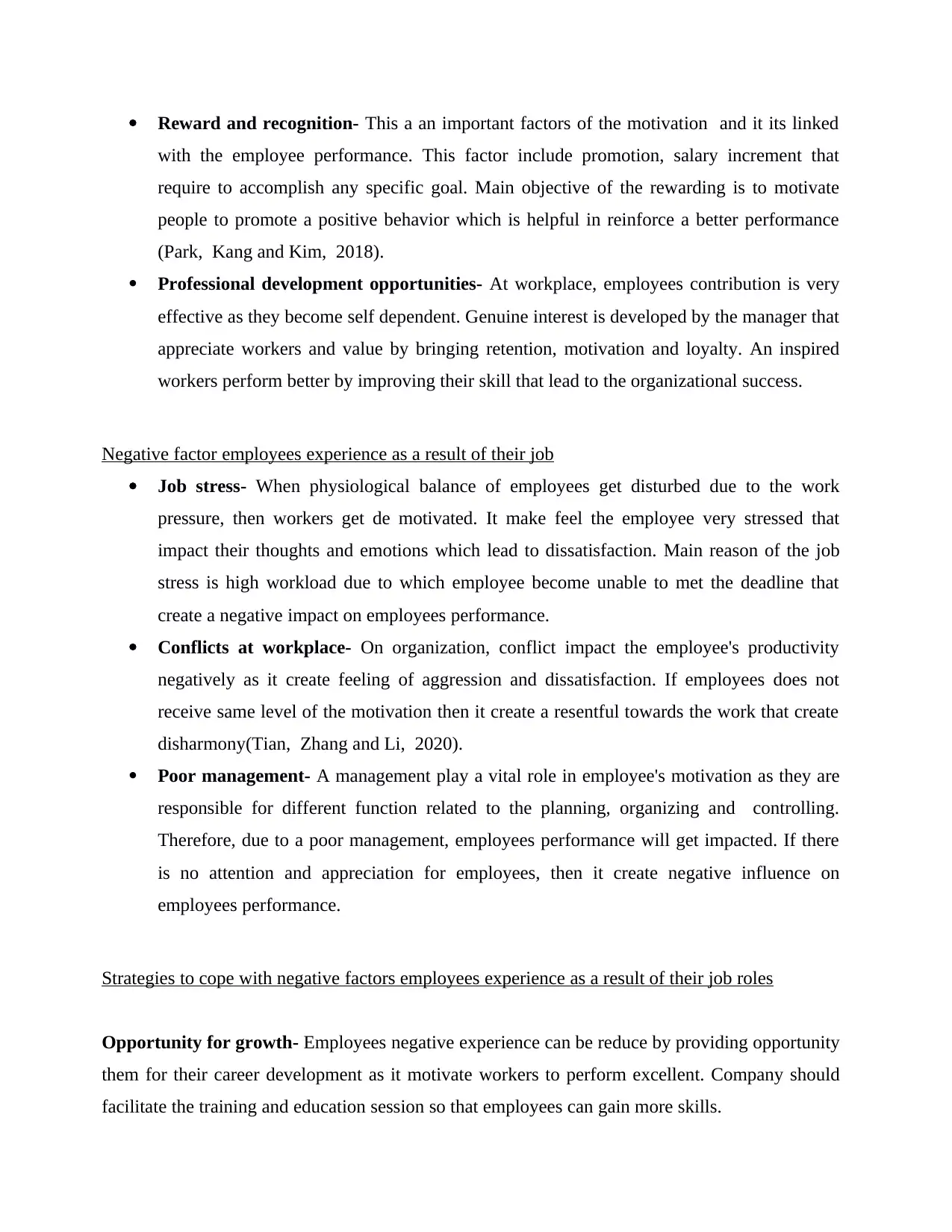
Reward and recognition- This a an important factors of the motivation and it its linked
with the employee performance. This factor include promotion, salary increment that
require to accomplish any specific goal. Main objective of the rewarding is to motivate
people to promote a positive behavior which is helpful in reinforce a better performance
(Park, Kang and Kim, 2018).
Professional development opportunities- At workplace, employees contribution is very
effective as they become self dependent. Genuine interest is developed by the manager that
appreciate workers and value by bringing retention, motivation and loyalty. An inspired
workers perform better by improving their skill that lead to the organizational success.
Negative factor employees experience as a result of their job
Job stress- When physiological balance of employees get disturbed due to the work
pressure, then workers get de motivated. It make feel the employee very stressed that
impact their thoughts and emotions which lead to dissatisfaction. Main reason of the job
stress is high workload due to which employee become unable to met the deadline that
create a negative impact on employees performance.
Conflicts at workplace- On organization, conflict impact the employee's productivity
negatively as it create feeling of aggression and dissatisfaction. If employees does not
receive same level of the motivation then it create a resentful towards the work that create
disharmony(Tian, Zhang and Li, 2020).
Poor management- A management play a vital role in employee's motivation as they are
responsible for different function related to the planning, organizing and controlling.
Therefore, due to a poor management, employees performance will get impacted. If there
is no attention and appreciation for employees, then it create negative influence on
employees performance.
Strategies to cope with negative factors employees experience as a result of their job roles
Opportunity for growth- Employees negative experience can be reduce by providing opportunity
them for their career development as it motivate workers to perform excellent. Company should
facilitate the training and education session so that employees can gain more skills.
with the employee performance. This factor include promotion, salary increment that
require to accomplish any specific goal. Main objective of the rewarding is to motivate
people to promote a positive behavior which is helpful in reinforce a better performance
(Park, Kang and Kim, 2018).
Professional development opportunities- At workplace, employees contribution is very
effective as they become self dependent. Genuine interest is developed by the manager that
appreciate workers and value by bringing retention, motivation and loyalty. An inspired
workers perform better by improving their skill that lead to the organizational success.
Negative factor employees experience as a result of their job
Job stress- When physiological balance of employees get disturbed due to the work
pressure, then workers get de motivated. It make feel the employee very stressed that
impact their thoughts and emotions which lead to dissatisfaction. Main reason of the job
stress is high workload due to which employee become unable to met the deadline that
create a negative impact on employees performance.
Conflicts at workplace- On organization, conflict impact the employee's productivity
negatively as it create feeling of aggression and dissatisfaction. If employees does not
receive same level of the motivation then it create a resentful towards the work that create
disharmony(Tian, Zhang and Li, 2020).
Poor management- A management play a vital role in employee's motivation as they are
responsible for different function related to the planning, organizing and controlling.
Therefore, due to a poor management, employees performance will get impacted. If there
is no attention and appreciation for employees, then it create negative influence on
employees performance.
Strategies to cope with negative factors employees experience as a result of their job roles
Opportunity for growth- Employees negative experience can be reduce by providing opportunity
them for their career development as it motivate workers to perform excellent. Company should
facilitate the training and education session so that employees can gain more skills.
⊘ This is a preview!⊘
Do you want full access?
Subscribe today to unlock all pages.

Trusted by 1+ million students worldwide
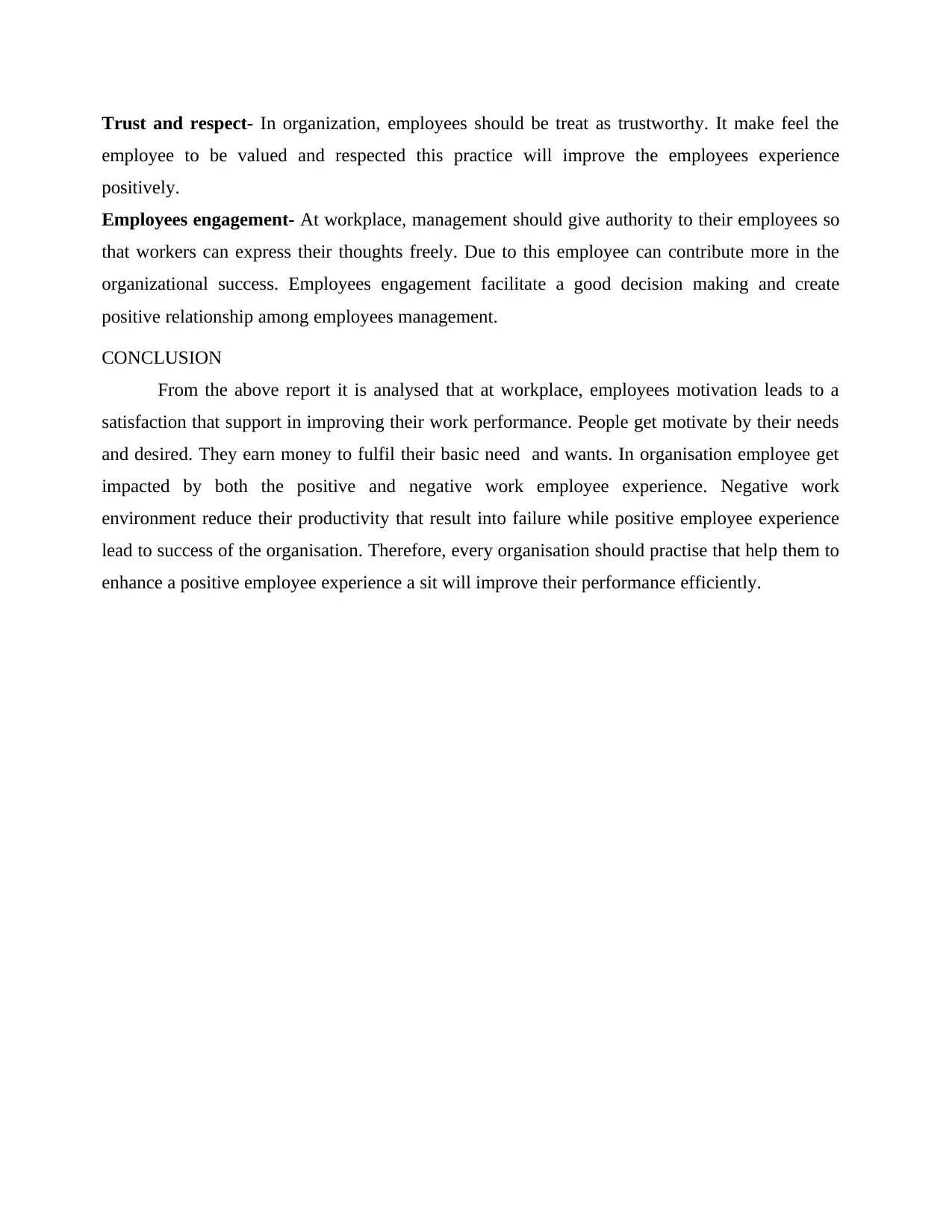
Trust and respect- In organization, employees should be treat as trustworthy. It make feel the
employee to be valued and respected this practice will improve the employees experience
positively.
Employees engagement- At workplace, management should give authority to their employees so
that workers can express their thoughts freely. Due to this employee can contribute more in the
organizational success. Employees engagement facilitate a good decision making and create
positive relationship among employees management.
CONCLUSION
From the above report it is analysed that at workplace, employees motivation leads to a
satisfaction that support in improving their work performance. People get motivate by their needs
and desired. They earn money to fulfil their basic need and wants. In organisation employee get
impacted by both the positive and negative work employee experience. Negative work
environment reduce their productivity that result into failure while positive employee experience
lead to success of the organisation. Therefore, every organisation should practise that help them to
enhance a positive employee experience a sit will improve their performance efficiently.
employee to be valued and respected this practice will improve the employees experience
positively.
Employees engagement- At workplace, management should give authority to their employees so
that workers can express their thoughts freely. Due to this employee can contribute more in the
organizational success. Employees engagement facilitate a good decision making and create
positive relationship among employees management.
CONCLUSION
From the above report it is analysed that at workplace, employees motivation leads to a
satisfaction that support in improving their work performance. People get motivate by their needs
and desired. They earn money to fulfil their basic need and wants. In organisation employee get
impacted by both the positive and negative work employee experience. Negative work
environment reduce their productivity that result into failure while positive employee experience
lead to success of the organisation. Therefore, every organisation should practise that help them to
enhance a positive employee experience a sit will improve their performance efficiently.
Paraphrase This Document
Need a fresh take? Get an instant paraphrase of this document with our AI Paraphraser
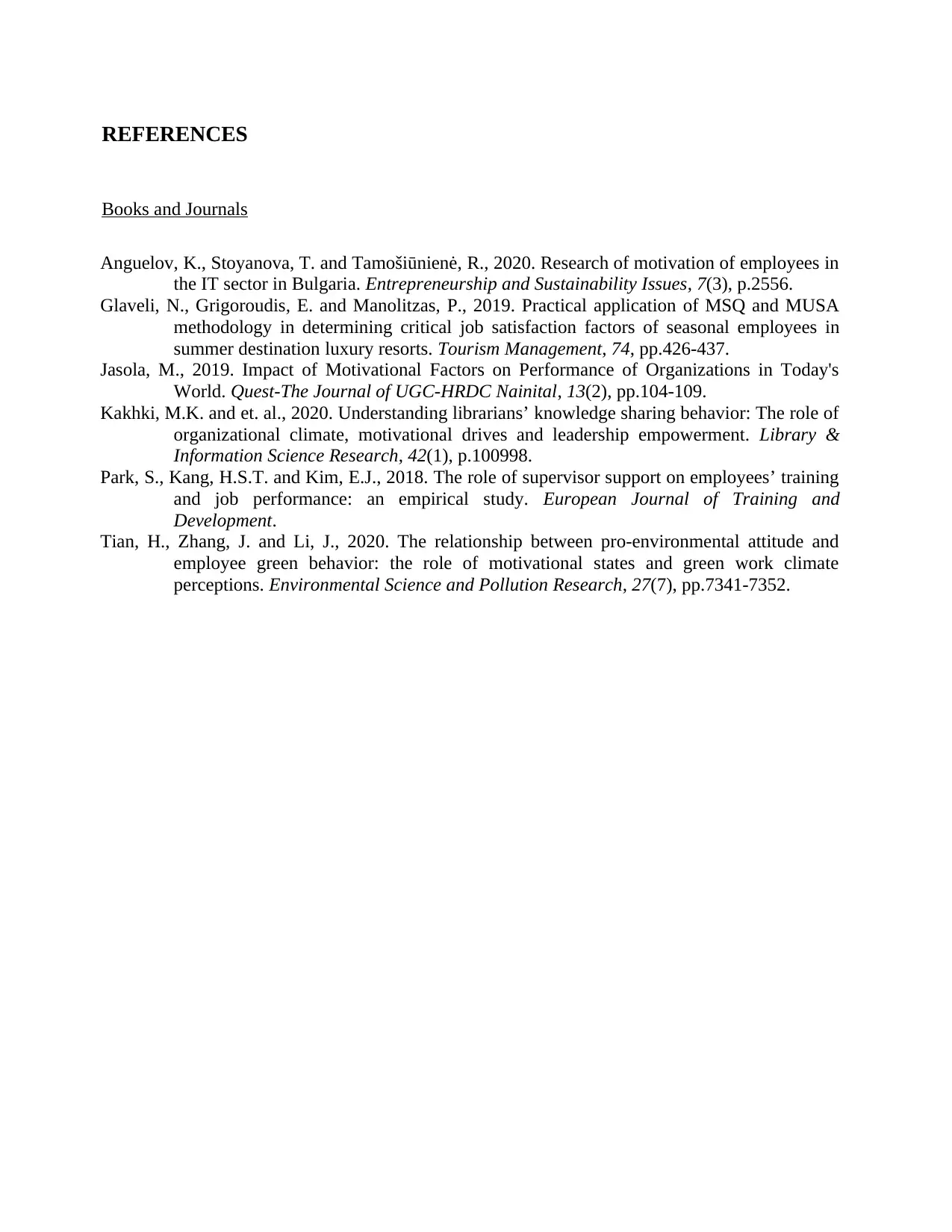
REFERENCES
Books and Journals
Anguelov, K., Stoyanova, T. and Tamošiūnienė, R., 2020. Research of motivation of employees in
the IT sector in Bulgaria. Entrepreneurship and Sustainability Issues, 7(3), p.2556.
Glaveli, N., Grigoroudis, E. and Manolitzas, P., 2019. Practical application of MSQ and MUSA
methodology in determining critical job satisfaction factors of seasonal employees in
summer destination luxury resorts. Tourism Management, 74, pp.426-437.
Jasola, M., 2019. Impact of Motivational Factors on Performance of Organizations in Today's
World. Quest-The Journal of UGC-HRDC Nainital, 13(2), pp.104-109.
Kakhki, M.K. and et. al., 2020. Understanding librarians’ knowledge sharing behavior: The role of
organizational climate, motivational drives and leadership empowerment. Library &
Information Science Research, 42(1), p.100998.
Park, S., Kang, H.S.T. and Kim, E.J., 2018. The role of supervisor support on employees’ training
and job performance: an empirical study. European Journal of Training and
Development.
Tian, H., Zhang, J. and Li, J., 2020. The relationship between pro-environmental attitude and
employee green behavior: the role of motivational states and green work climate
perceptions. Environmental Science and Pollution Research, 27(7), pp.7341-7352.
Books and Journals
Anguelov, K., Stoyanova, T. and Tamošiūnienė, R., 2020. Research of motivation of employees in
the IT sector in Bulgaria. Entrepreneurship and Sustainability Issues, 7(3), p.2556.
Glaveli, N., Grigoroudis, E. and Manolitzas, P., 2019. Practical application of MSQ and MUSA
methodology in determining critical job satisfaction factors of seasonal employees in
summer destination luxury resorts. Tourism Management, 74, pp.426-437.
Jasola, M., 2019. Impact of Motivational Factors on Performance of Organizations in Today's
World. Quest-The Journal of UGC-HRDC Nainital, 13(2), pp.104-109.
Kakhki, M.K. and et. al., 2020. Understanding librarians’ knowledge sharing behavior: The role of
organizational climate, motivational drives and leadership empowerment. Library &
Information Science Research, 42(1), p.100998.
Park, S., Kang, H.S.T. and Kim, E.J., 2018. The role of supervisor support on employees’ training
and job performance: an empirical study. European Journal of Training and
Development.
Tian, H., Zhang, J. and Li, J., 2020. The relationship between pro-environmental attitude and
employee green behavior: the role of motivational states and green work climate
perceptions. Environmental Science and Pollution Research, 27(7), pp.7341-7352.
1 out of 8
Related Documents
Your All-in-One AI-Powered Toolkit for Academic Success.
+13062052269
info@desklib.com
Available 24*7 on WhatsApp / Email
![[object Object]](/_next/static/media/star-bottom.7253800d.svg)
Unlock your academic potential
Copyright © 2020–2025 A2Z Services. All Rights Reserved. Developed and managed by ZUCOL.



